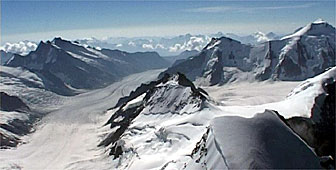Mountaineers celebrate arrival at Jungfrau summit

Seven Swiss and British climbers dressed in 19th-century climbing gear breathed a collective sigh of relief and toasted their success with champagne on Tuesday when they scaled the summit of the Jungfrau on the third leg of a 10-day mountaineering expedition.
The group left the Konkordia Hut under a brilliant starry sky at around 3am and made its way towards the gentle snowy slopes of the Jungfraufirn.
One of the team members, Alison Henry, found by the third day of the expedition she was suffering from a combination of lack of sleep and altitude sickness.
Henry, who works in Britain restoring and advising on conservation methods for historic buildings, was forced to leave the group to tackle the ascent without her while she went directly to the Mönchsjoch Hut, where the third day of the trek was due to end.
The rest of the team quickly discovered that their 19th century long-handled ice-axes were a mixed blessing. They doubled as convenient walking sticks while crossing glaciers, but proved to be cumbersome on the steep slopes of the Jungfrau.
As the climb went on, the group soon realised that an assault on the Jungfrau on a clear summer’s day, with or without turn-of-the-century equipment, is more dangerous than ever before.
Climbers not alone
A century ago, the team would have been tackling the slopes alone, whereas on Wednesday’s climb they were joined by up to 80 other mountaineers making their way towards the summit.
Inexperienced climbers, the group observed, can cause rockslides. On two occasions, the team watched as boulders tumbled down towards them, only to bounce away harmlessly at the last minute.
Team member Les Swindin, who has been climbing in the Alps since 1965, said the group’s first task after reaching the summit was to plant a fir tree in memory of a group of mountaineers who first reached the summit in 1811.
“Back then, nobody believed the party had climbed the mountain,” Swindin said.
“So the son of one the climbers came back again in 1812 and planted a fir tree at the summit just to prove that they had been there – so I suppose you could say that we were also proving that we have been here too,” he added.
Celebrating with champagne
Once the tree was planted, the group focused on the more immediate task of celebrating their arrival at the top with a bottle of champagne – on ice, of course.
As they gazed out over the panoramic view of Alpine peaks, the Alps Walk team members indulged in another 19th century Alpine tradition: the ritual passing round of the bottle for a collective toast to the peaks and to the continued success of the expedition.
“This was a tradition in the 19th century for climbers who made their first ascents,” Swindin said as he drained the bottle into his glass.
“Early mountaineers liked to enjoy a bottle of champagne on the summit and we’re doing the same thing today.”
Swindin, who has climbed every 4,000-metre summit in the Alps, was making his third visit to the 4,158 metre Jungfrau.
Unsurpassable view
“It’s just great to be on a high mountain in the Alps, particularly this one, because the view from here is almost unsurpassable,” he said after an arduous eight-hour trek to the summit.
swissinfo’s Dale Bechtel, who is following the group throughout the expedition, said the hardest part of climbing to the top of a mountain was “facing up to the reality that you then have to go all the way back down again”.
And so it was that the group trekked back down across a heavy, wet snow to finish the day and rest for the night at the Mönchsjoch Hut.
“As we passed the Jungfraujoch railway station,” Bechtel said, “we saw crowds of Japanese tourists playing in the snow and taking short rides in helicopters to see the Jungfrau the easy way.”
The aim of the expedition, which can be followed every day on swissinfo, is to trace the history and the development of mountaineering as well as chart changes to the natural environment over the past century.
swissinfo

In compliance with the JTI standards
More: SWI swissinfo.ch certified by the Journalism Trust Initiative
You can find an overview of ongoing debates with our journalists here . Please join us!
If you want to start a conversation about a topic raised in this article or want to report factual errors, email us at english@swissinfo.ch.